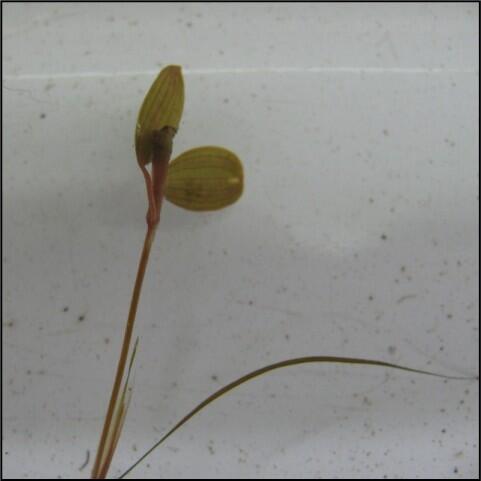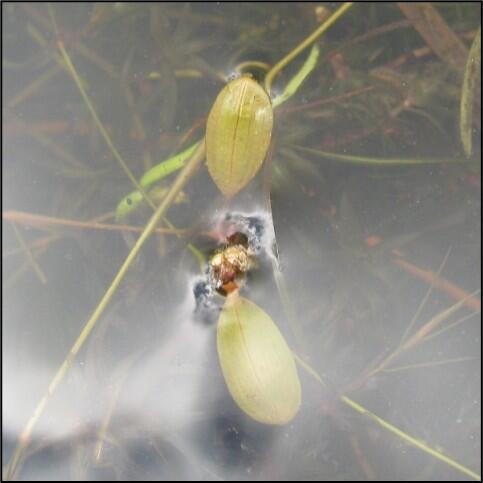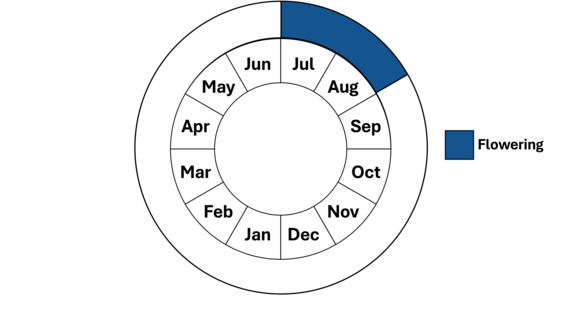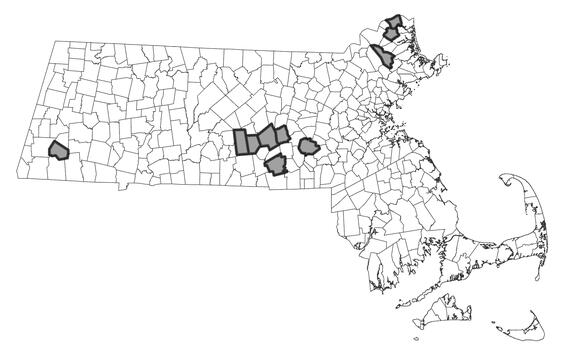- Scientific name: Potamogeton vaseyi
- Species of Greatest Conservation Need (MA State Wildlife Action Plan)
- Endangered (MA Endangered Species Act)
Description

Reproductive individuals of Vasey’s pondweed have linear submersed leaves as well as expanded floating leaves with petioles.
Vasey’s pondweed (Potamogeton vaseyi) is a delicate, submersed aquatic herb in the Pondweed family (Potamogetonaceae), with erect stems that are rooted in the substrate. Fertile individuals have two types of foliage: expanded floating leaves and slender submersed leaves. Submersed blades are light green, sessile, and linear-filiform (≤ 1 mm [0.04 in] wide), with acute to almost bristle-tipped apices. Floating blades are greenish brown, petioled, and elliptical to obovate with obtuse apices. Flowers are inconspicuous and arranged in cylindrical spikes raised above the water surface. Fruits are small and seed-like, obovoid, and distinctly keeled. Leafy winter-buds (turions) are common in submersed leaf axils.
Identification of pondweeds (Potamogeton spp.) requires use of a technical manual. Vasey’s pondweed is identified by translucent, one (to three) veined, submersed blades and small stipules completely free from the leaf bases. Reproductive individuals have small (0.6-1.5 cm long, 3-8 mm wide; 0.24-0.59 in long, 0.12-0.31 in wide) floating blades with five to nine veins, and small, dorsally keeled fruits with short, recurved beaks. Small, soft turions are common in leaf axils or on axillary branches from early summer to fall. Plants should be identified in fruit, when fruits and vegetative features are distinctive. Vasey’s pondweed is difficult to locate in late summer as plants typically deteriorate by mid-August.
Individuals of vasey’s pondweed with floating leaves resemble those of the common northern snail-seed pondweed (P. spirillus); however, vasey’s pondweed is distinguished by its free stipules, keeled and beaked fruits, presence of winter-buds, and lack of any submersed spikes. Plants without floating leaves closely resemble other common narrow-leaved pondweeds such as slender pondweed (P. pusillus) and leafy pondweed (P. foliosus). Vasey’s pondweed can be separated from the former species by its lack of nodal glands and from either species by its strictly axillary turions. Both slender pondweed and leafy pondweed can have terminal turions in addition to those on short axillary branches. Leafy pondweed may also have wider submersed blades (up to 2.3 mm [0.09 in]) than Vasey’s pondweed.

Flower spikes are raised above the water surface.
Life cycle and behavior

Distribution in Massachusetts. 1999-2024. Based on records in the Natural Heritage Database.
Population status
Vasey’s pondweed is listed under the Massachusetts Endangered Species Act as endangered. All listed species are protected from killing, collecting, possessing, or sale, and from activities that would destroy habitat and thus directly or indirectly cause mortality or disrupt critical behaviors. The Natural Heritage & Endangered Species Program has 17 records from 5 counties: Berkshire, Essex, Middlesex, Norfolk, and Worcester. Six of these records have been observed within the last 25 years.

Distribution in Massachusetts. 1999-2024. Based on records in the Natural Heritage Database.
Distribution and abundance
Vasey’s pondweed occurs from southern New Brunswick west to Quebec, and south to Minnesota, Illinois, Pennsylvania, and New Jersey.
Habitat
Vasey’s pondweed occurs in freshwater lakes, ponds, and slow-moving rivers in quiet, open water up to 2 m (6.5 ft) deep. It generally favors acid to moderately alkaline waters. Plants found in association with vasey’s pondweed include slender pondweed (P. pusillus), flatstem pondweed (P. zosteriformis), big-leaved pondweed (P. amplifolius), water crowfoot (Ranunculus aquatilis), common bladderwort (Utricularia macrorhiza), nuttall’s water-weed (Elodea nuttallii), and eurasian water-milfoil (Myriophyllum spicatum).
Healthy habitats are vital for supporting native wildlife and plants. Explore habitats and learn about conservation and restoration in Massachusetts.
Threats
As for many rare species, the exact management needs for Vasey’s pondweed are not known. However, because this plant occurs in open waters, any alteration in the hydrologic regime, water quality, or erosion and sedimentation rates could presumably impact the species. Competition from invasive aquatic species may also reduce the available habitat for Vasey’s pondweed. Mechanical or non-specific chemical control of invasive species may threaten populations of Vasey’s pondweed.
Conservation
All active management of rare plant populations (including invasive species removal) is subject to review under the Massachusetts Endangered Species Act and should be planned in close consultation with the MassWildlife’s Natural Heritage & Endangered Species Program.
References
Crow, G. E., and C.B. Hellquist. 2000. Aquatic and Wetland Plants of North America. Vol. 2. University of Wisconsin Press, Madison.
Les, D.H., N.M. Murray, and N.P. Tippery. 2009. Systematics of two imperiled Pondweeds (Potamogeton vaseyi, P. gemmiparus) and taxonomic ramifications for Subsection Pusilli (Potamogetonaceae). Systematic Botany 34: 643–651.
Contact
| Date published: | May 5, 2025 |
|---|